The beans I planted the other day are doing well and growing strong. Beans like it pretty hot and these Hopi Purple Pods are no exceptions.
 |
| Hopi Purple Pod bean seedlings June 2011 |
 |
| Hopi Purple Pod bean seedlings June 2011 |
 |
| Sunflower Seedlings, June 2011 |
 |
| Snapdragon Seedlings |
 |
| Hopi Purple Pod Bean seedlings |
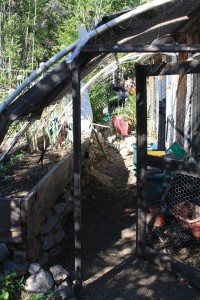
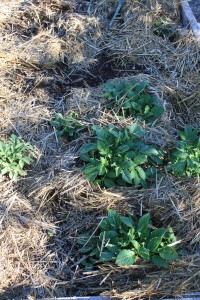
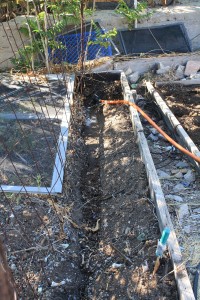 First I dug a good size trench next to the trellis and watered it well. The ground is very very dry and I’m trying to get moisture to the root zone.
First I dug a good size trench next to the trellis and watered it well. The ground is very very dry and I’m trying to get moisture to the root zone.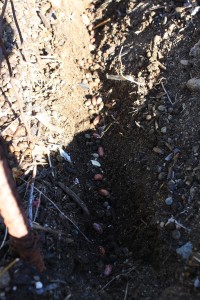
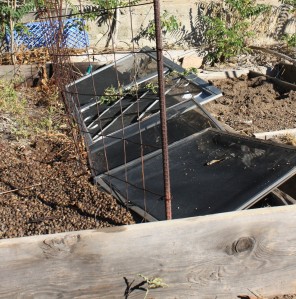
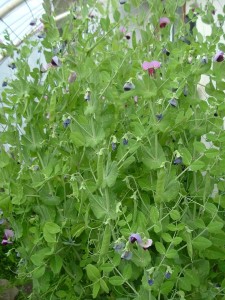
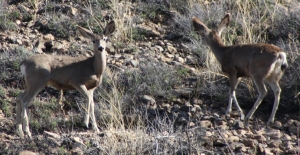
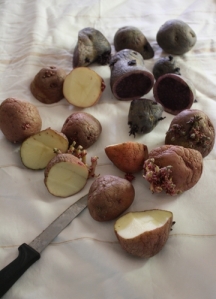







 Spring comes early, like January and February, starting with the Paperwhites.
Spring comes early, like January and February, starting with the Paperwhites. Then the short bearded iris come on. I have solid white and a purple kind. I think of these as being the old-fashioned ones because they were here when I moved in. I see them all over town. They do so well that when they get over crowded and I have to divide them I have even put them up on the side of the hill and along the creek bank. They are good to help control erosion. As long as they are not in a real hot spot they can get along without extra water, though they will bloom more prolifically if they have some.
Then the short bearded iris come on. I have solid white and a purple kind. I think of these as being the old-fashioned ones because they were here when I moved in. I see them all over town. They do so well that when they get over crowded and I have to divide them I have even put them up on the side of the hill and along the creek bank. They are good to help control erosion. As long as they are not in a real hot spot they can get along without extra water, though they will bloom more prolifically if they have some.
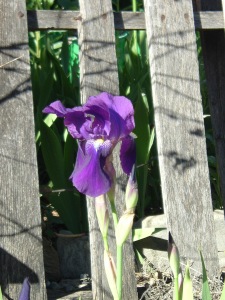
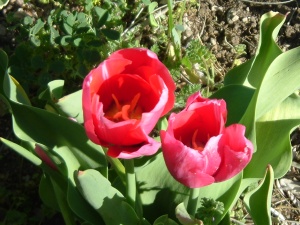 There are a few tulips around the yard. [Did you know you can eat tulip flowers?]
There are a few tulips around the yard. [Did you know you can eat tulip flowers?]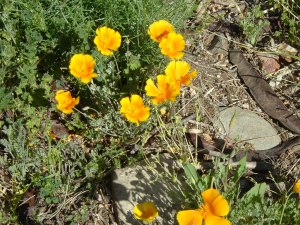 Some California poppies. These bloom all along the highways and on the hills around here.
Some California poppies. These bloom all along the highways and on the hills around here. Later come the tall bearded iris. I don’t know the name of this variety either. This one grows about 3 1/2 feet tall with as many as 6 blooms to a stalk.
Later come the tall bearded iris. I don’t know the name of this variety either. This one grows about 3 1/2 feet tall with as many as 6 blooms to a stalk. About the same time these tall yellow ones come along, tho they are not quite as tall as the ones above.
About the same time these tall yellow ones come along, tho they are not quite as tall as the ones above. Over on the hillsides the cactus are blooming; this one is called a hedgehog. The photo does not really give you the true color; it is much more intense, nearly fluorescent.
Over on the hillsides the cactus are blooming; this one is called a hedgehog. The photo does not really give you the true color; it is much more intense, nearly fluorescent.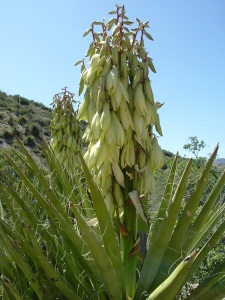 Here is a yucca blooming. They are related to our garden lilies. The Native Americans used this plant for making baskets and shoes. The would strip the fibers off the leaves and the sharp points provided a ready-made needle. Also, they would watch the plants in early spring and when the bloom stalk started to swell up out of the plant they would cut the plant down and roast the middle of it in the embers of their fire. The plant stores up a lot of carbohydrate in preparation for blooming and setting seeds. When roasted those carbs turn to sugars and made a sweet treat.
Here is a yucca blooming. They are related to our garden lilies. The Native Americans used this plant for making baskets and shoes. The would strip the fibers off the leaves and the sharp points provided a ready-made needle. Also, they would watch the plants in early spring and when the bloom stalk started to swell up out of the plant they would cut the plant down and roast the middle of it in the embers of their fire. The plant stores up a lot of carbohydrate in preparation for blooming and setting seeds. When roasted those carbs turn to sugars and made a sweet treat.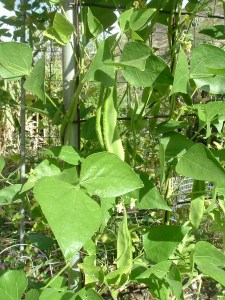 Here are the King of the Garden Limas, finally! I picked 1 1/2 pounds the other day, which shelled out to about a quart of beans, cooked them up with bacon & onion, delish! Even Liberty liked them.
Here are the King of the Garden Limas, finally! I picked 1 1/2 pounds the other day, which shelled out to about a quart of beans, cooked them up with bacon & onion, delish! Even Liberty liked them.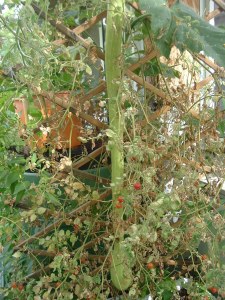 Here a Trombocino squash {seeds available from www.freedomseeds.com} hides in the Red Currant tomato
Here a Trombocino squash {seeds available from www.freedomseeds.com} hides in the Red Currant tomato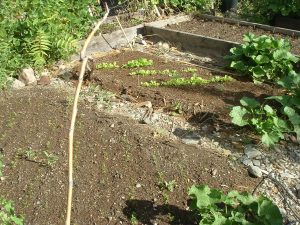 The bed at the bottom of the picture has baby carrots, the one farther away, Golden Globe turnips and parsnips. The bigger green plants are hollyhocks.
The bed at the bottom of the picture has baby carrots, the one farther away, Golden Globe turnips and parsnips. The bigger green plants are hollyhocks.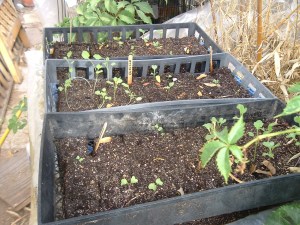 Broccoli and cauliflower seedlings wait in the wings.
Broccoli and cauliflower seedlings wait in the wings.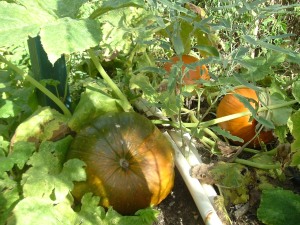 Kabocha squash volunteers have run over quite a bit of the garden. The one in the front isn’t quite ready to pick. The ones in the back weighed 7 & 10 pounds each. The other one is twice as big, can’t wait to see how much it weighs.
Kabocha squash volunteers have run over quite a bit of the garden. The one in the front isn’t quite ready to pick. The ones in the back weighed 7 & 10 pounds each. The other one is twice as big, can’t wait to see how much it weighs.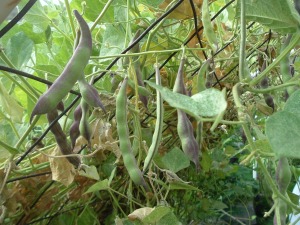 Lovely Hopi purple pod beans. These are yummy as fresh or dried shellies.
Lovely Hopi purple pod beans. These are yummy as fresh or dried shellies.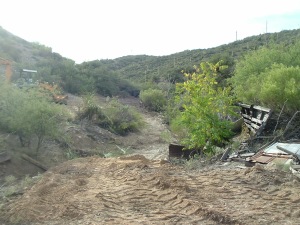
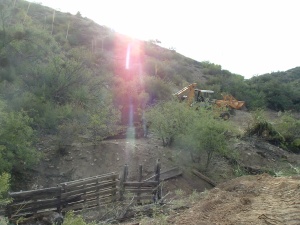
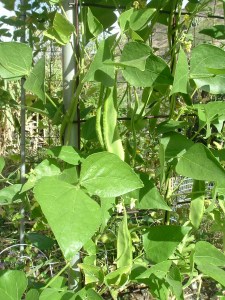 As predicted, once the weather began to cool off those 11 foot tall Lima beans began setting pods.
As predicted, once the weather began to cool off those 11 foot tall Lima beans began setting pods.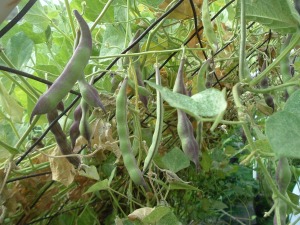 Hopi Purple Pod beans, a Native American variety, have set thick clusters of pods. I love this bean because it sets bunches of pods, I can fill the bowl in a few minutes, picking fistfuls of beans at a time. Picked really tiny you _can_ eat them as green beans, but they are at their best as green or dried shelled beans. They look a little like red pinto beans and have a full bodied meaty bean taste.
Hopi Purple Pod beans, a Native American variety, have set thick clusters of pods. I love this bean because it sets bunches of pods, I can fill the bowl in a few minutes, picking fistfuls of beans at a time. Picked really tiny you _can_ eat them as green beans, but they are at their best as green or dried shelled beans. They look a little like red pinto beans and have a full bodied meaty bean taste. Bean soup, potatoe soup, dilly beans, green beans, pickled peppers, tomato sauce, pickled eggs… there’s more you can’t see, blueberries, apple sauce, jams, jellies, pickles, sauces, marinades. This year not everything was grown at home. I took advantage of terrific sales and the farmer’s market. But next year most of the cupboards will be filled with home grown goodness. Also not in this picture are the things that I’ve dried, plums, apples, raisins, tomatoes, jerky, herbs for seasoning and tea.
Bean soup, potatoe soup, dilly beans, green beans, pickled peppers, tomato sauce, pickled eggs… there’s more you can’t see, blueberries, apple sauce, jams, jellies, pickles, sauces, marinades. This year not everything was grown at home. I took advantage of terrific sales and the farmer’s market. But next year most of the cupboards will be filled with home grown goodness. Also not in this picture are the things that I’ve dried, plums, apples, raisins, tomatoes, jerky, herbs for seasoning and tea.